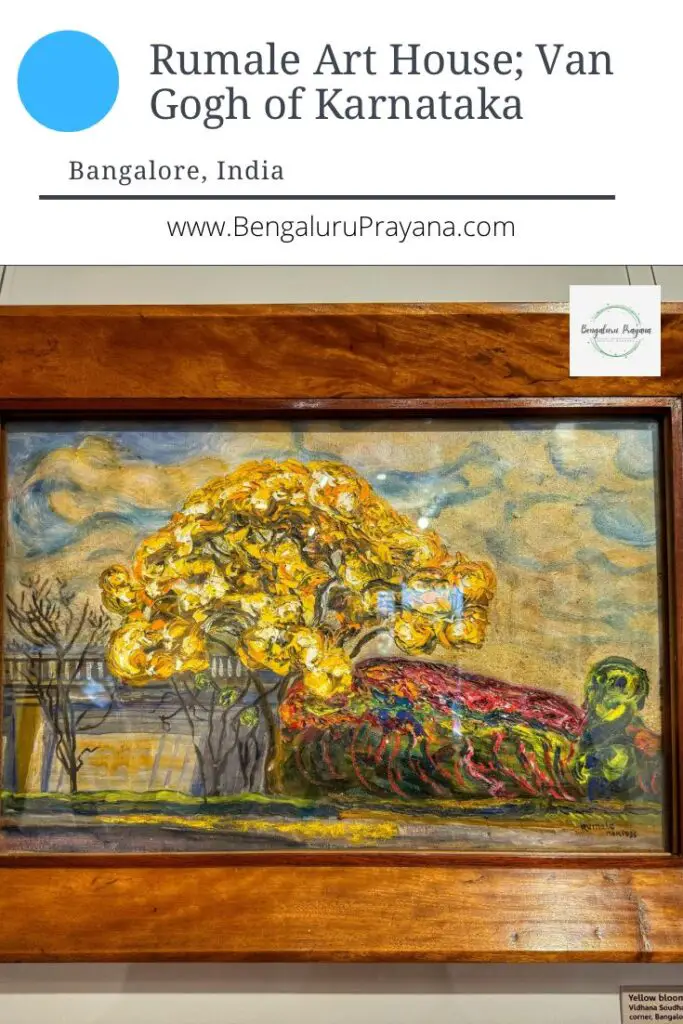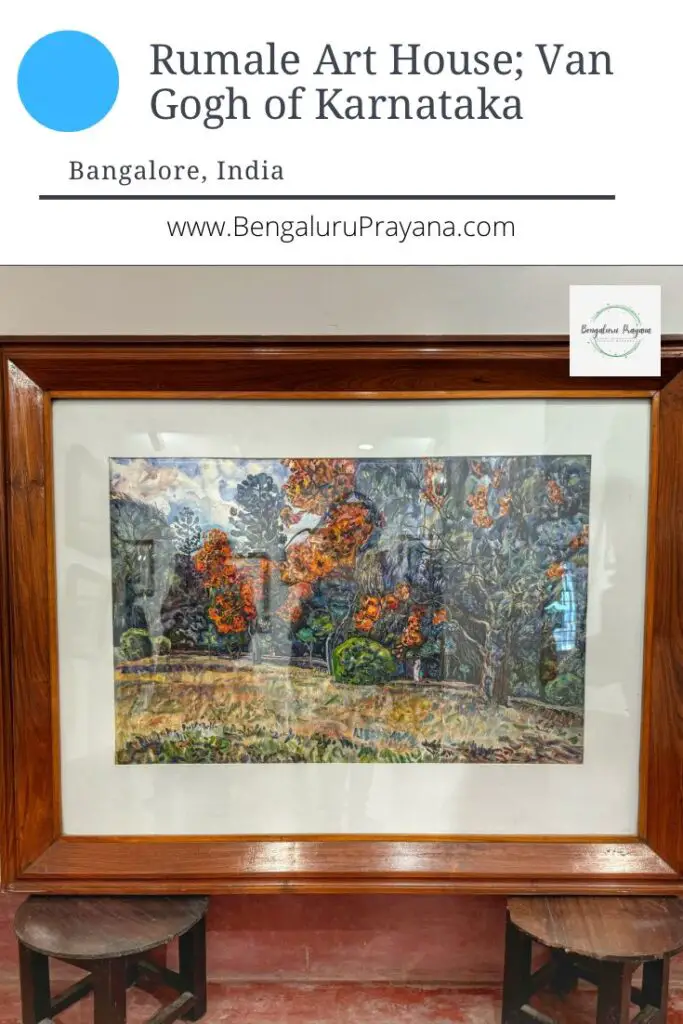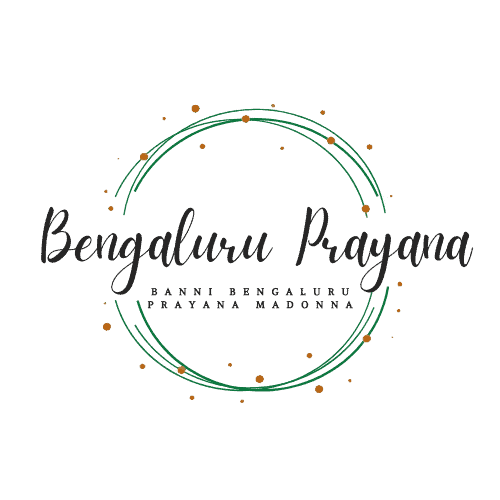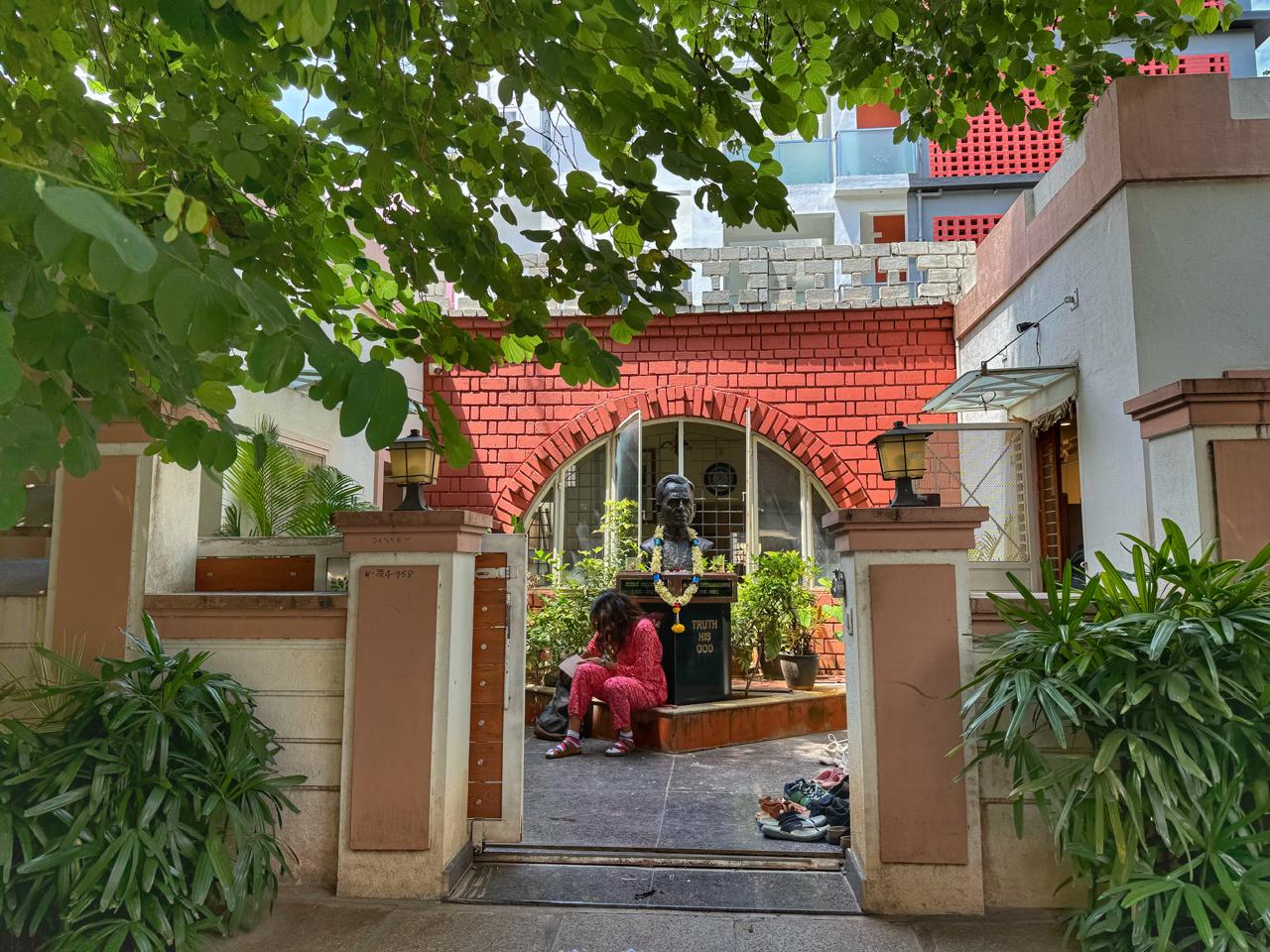Are you here to be swept away by the beautiful artwork at Rumale Art House in Bangalore’s Rajajinagar area? If yes, you’re in the right place! This post will walk you through everything you need to know about this hidden gem, from the history and artwork of Rumale Art House to the life and legacy of its celebrated artist, Rumale Chennabasaviah. Known as the “Van Gogh of Karnataka,” Chennabasaviah’s art captures the heart and soul of Karnataka, blending vibrant landscapes with scenes of local life that reflect his unique perspective as a self-taught artist.
Having spent much of my life around Malleshwaram and Rajajinagar, I was surprised to realise I had never heard of Rumale Art House until I came across a post from the Urban Sketchers community. Intrigued and happy to find an art gallery so close to home, I decided to visit it. Rumale Art House, nestled in Rajajinagar, is a treasure trove of work by Rumale Chennabasaviah, a visionary painter fondly called the “Van Gogh of Karnataka.”
Entering the gallery, I was immediately captivated by the vibrancy and expressiveness of his paintings. The colours, themes, and strokes held an energy and emotion that seemed to mirror Karnataka’s cultural spirit and the artist’s unique perspective. Beyond just a display of paintings, Rumale Art House offers a glimpse into the life of an extraordinary individual whose journey spanned art, social activism, and freedom fighting. Chennabasaviah’s self-taught artistry and commitment to portraying local landscapes, village life, and culture make this gallery an essential visit for anyone looking to experience art that resonates with personal passion and historical significance.
This article may contain affiliate links. For complete information, please see our affiliate disclaimer here.
Who Was Rumale Chennabasaviah?
Rumale Chennabasaviah (1910-1988) was remarkable in Karnataka’s cultural and social history. He was known for his artistry and dedication to India’s freedom struggle, making him a multi-faceted personality. Often called the “Van Gogh of Karnataka,” Rumale’s work captured the vibrant landscapes and cityscapes of Bengaluru with a unique style defined by bold, fast brush strokes and vivid colour choices. He often depicted local scenes of nature, architecture, and traditional life, leaving behind a legacy that celebrates the essence of old Bengaluru.
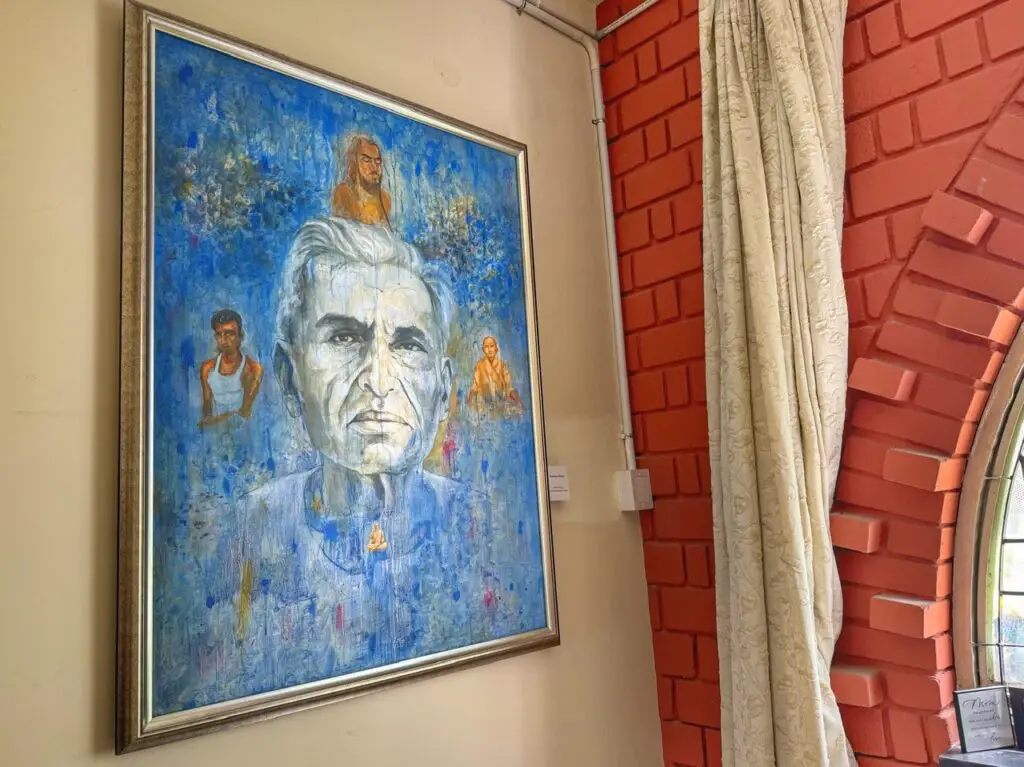
Aside from his talent in art, Rumale was deeply involved in social and political activism. He actively participated in Mahatma Gandhi’s non-violent resistance movement from 1930 to 1947. He later worked to shape the nation post-independence, even helping establish the Seva Dal to train youth in national service. For a brief period, he was elected to the Mysore Legislative Council and served as an editor for the Kannada daily Tainadu.
Art remained his greatest love, however, and after retiring from politics in 1962, he dedicated himself fully to it. He opened the Rumale Art House in 1973, Bengaluru’s first private gallery showcasing his work. Though he passed away tragically in 1988, Rumale Chennabasaviah’s art continues to inspire, capturing Karnataka’s spirit through powerful scenes of local life, religious sites, and Bengaluru’s landscapes, making him a celebrated figure in both art and activism.
Rumale’s Role in Indian Independence
Born on 10 September 1910, Rumale Chennabasaviah played an active role in India’s fight for independence. He joined Mahatma Gandhi’s non-violent resistance movement, participating in protests and activities that challenged British colonial rule. His dedication to freedom was unwavering; he spent years on the frontlines of this struggle, motivated by a deep sense of patriotism and belief in India’s self-determination.
Rumale’s commitment extended beyond protests. He was instrumental in shaping young minds for the cause through the Seva Dal, an organisation founded to train youth in national service and prepare them to contribute to an independent India. This involvement left a lasting impact on the community, instilling values of dedication and discipline among young Indians.
After India gained independence in 1947, Rumale continued to serve, helping establish the new state of Mysore (now Karnataka) and contributing to its legislative affairs. He was twice elected to the Mysore Legislative Council, where he worked on initiatives that supported nation-building. However, even with these responsibilities, Rumale’s love for art remained constant.
By 1962, he stepped away from politics and focused on painting. Yet his contribution to the freedom struggle and youth empowerment left an enduring legacy, and his artwork remains an example of his commitment to the country and its people.
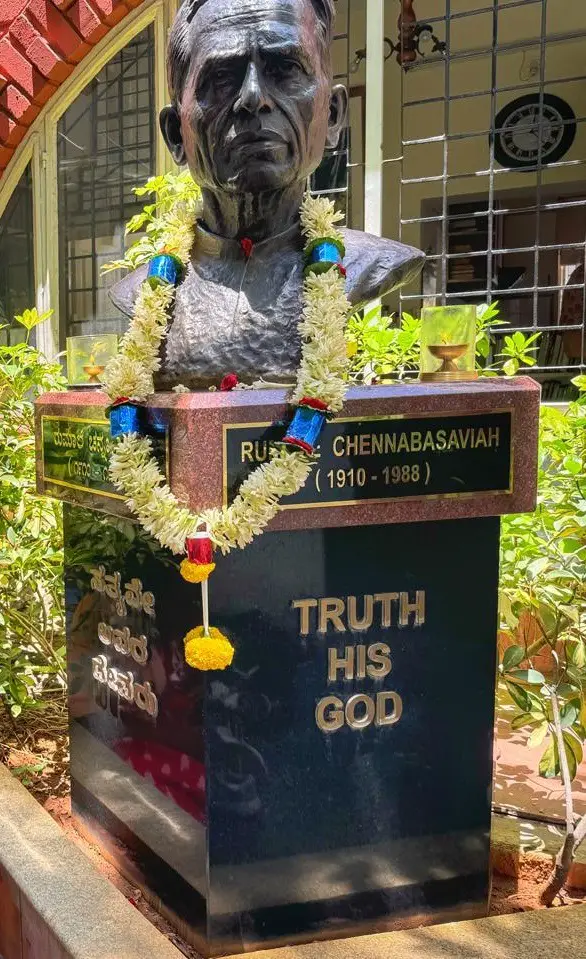
Rumale’s Painting Subjects
Rumale Chennabasaviah’s paintings capture the essence of Bangalore and Karnataka’s rich landscapes and urban life. His subjects were drawn from the vibrant streets and lush nature around him, creating a visual record of places that resonate with a timeless quality. His works often highlighted the everyday sights of old Bangalore, from quiet neighbourhood streets to bustling city centres, each scene captured in vibrant colours and bold strokes.
Nature was another frequent muse. Trees in full bloom, lush parks, and sprawling green spaces appeared regularly in Rumale’s works, reflecting his deep fascination with the natural world. His approach to these scenes was unique; he would spend hours studying a particular tree or landscape, often returning multiple times to capture it under different light and seasonal changes.
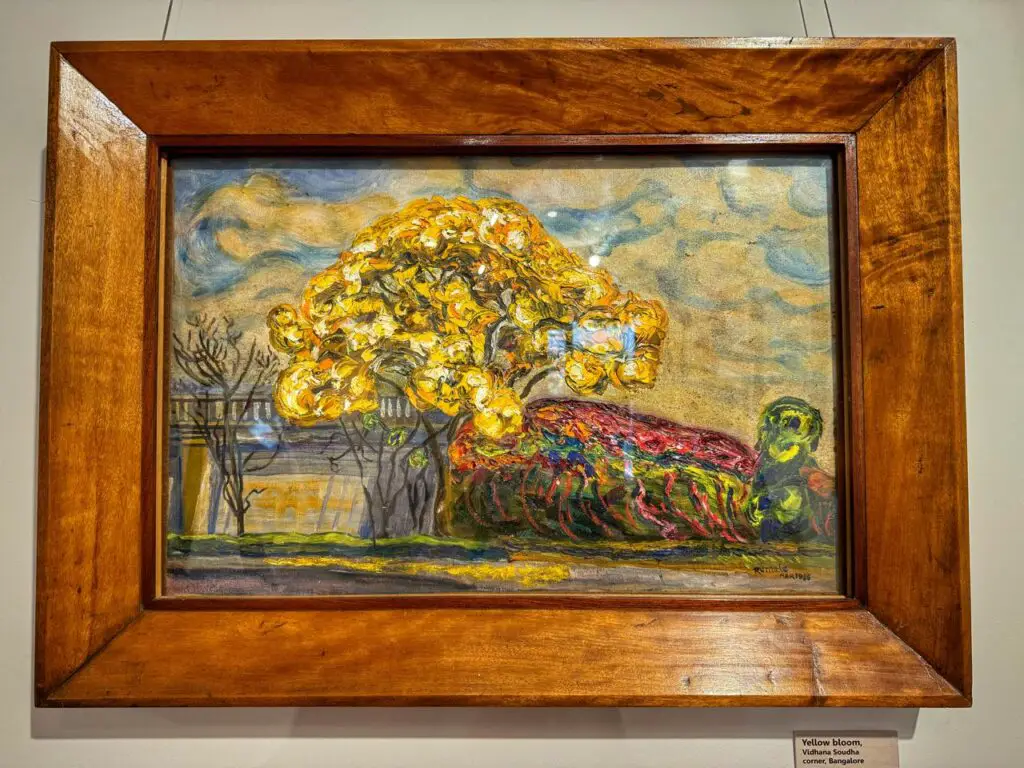
Notably, he also created works of religious and cultural significance, such as the “Kudalasangama,” an important pilgrimage site for the Lingayat community, and depictions of temples and deities. Each piece reflected his deep respect for Karnataka’s heritage and spiritual roots.
Rumale’s subjects weren’t limited to landscapes alone. He painted portraits of friends, mentors, and historical figures, each piece rich in colour and detail. Rumale immortalised a rapidly changing Bangalore with his paintings, preserving its charm and spirituality for future generations. His works are not just art; they bridge a bygone era of Bangalore‘s soul and spirit.
Rumale’s Spiritual Mentor
Rumale Chennabasaviah’s spiritual journey was guided by two influential mentors: Guru Sri Sri Sri Shivabalayogi Maharaj and Shreeman Tapaswiji Maharaj. These revered spiritual leaders greatly impacted Rumale’s life, grounding him in meditation and art. Shivabalayogi Maharaj introduced him to meditation, and this practice became central to Rumale’s creative process, helping him to channel inner peace and focus into his paintings. Meditation honed his concentration and shaped his signature style—bold, confident strokes and an intense colour palette.
Tapaswiji Maharaj was also instrumental in Rumale’s life, instilling values of discipline and dedication that further fueled his passion for art. His teachings encouraged Rumale to seek meaning beyond the surface of his work, imbuing his paintings with depth and spiritual resonance. His religious works, like Lord Shiva, Renuka Yellamma, and Shirdi Sai Baba paintings, show this influence. Rumale paid homage to the divine through these depictions, blending his faith with artistic expression.
These spiritual mentors helped shape Rumale’s vision, enabling him to create art that resonated with his inner beliefs and devotion. His works, in turn, became expressions of a life led with purpose and reverence.
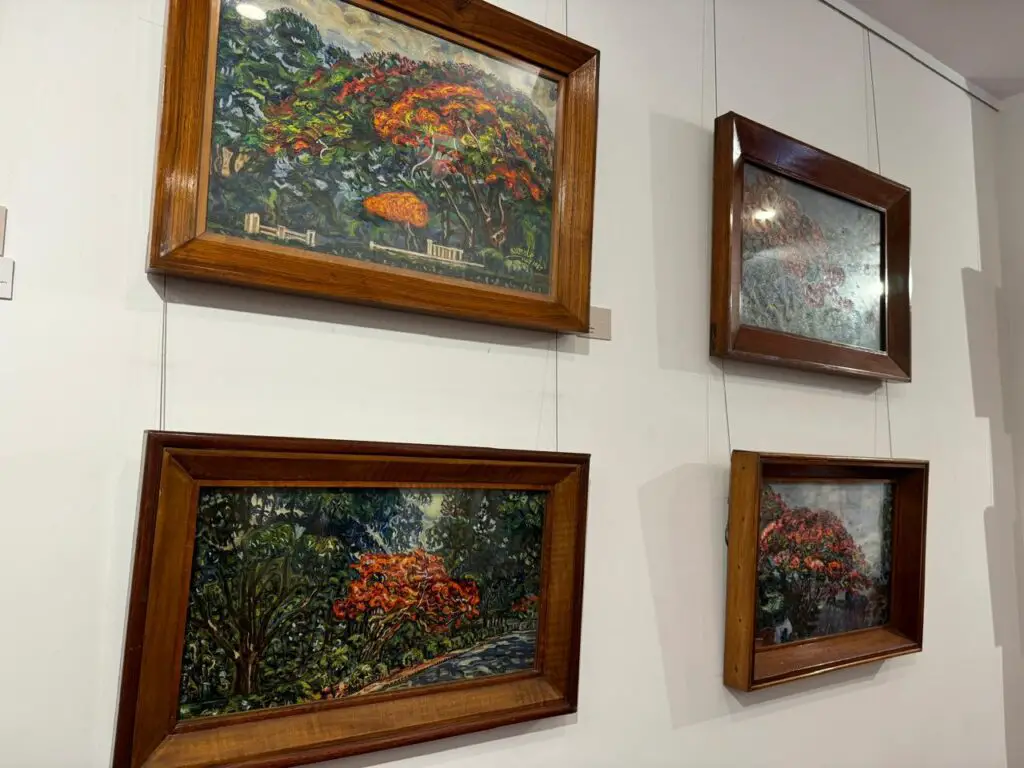
About Rumale Art House
Rumale Art House, located in Rajajinagar, Bengaluru, is a vibrant tribute to the life and works of Rumale Chennabasaviah. Established in 1973, the gallery is situated in Rumale’s former residence and houses approximately 120 original paintings, showcasing his unique artistic style. Managed by Sanjay Kabe, a close friend’s son, the Art House regularly rotates its display, featuring around 90 frames at any time to keep the gallery experience fresh.
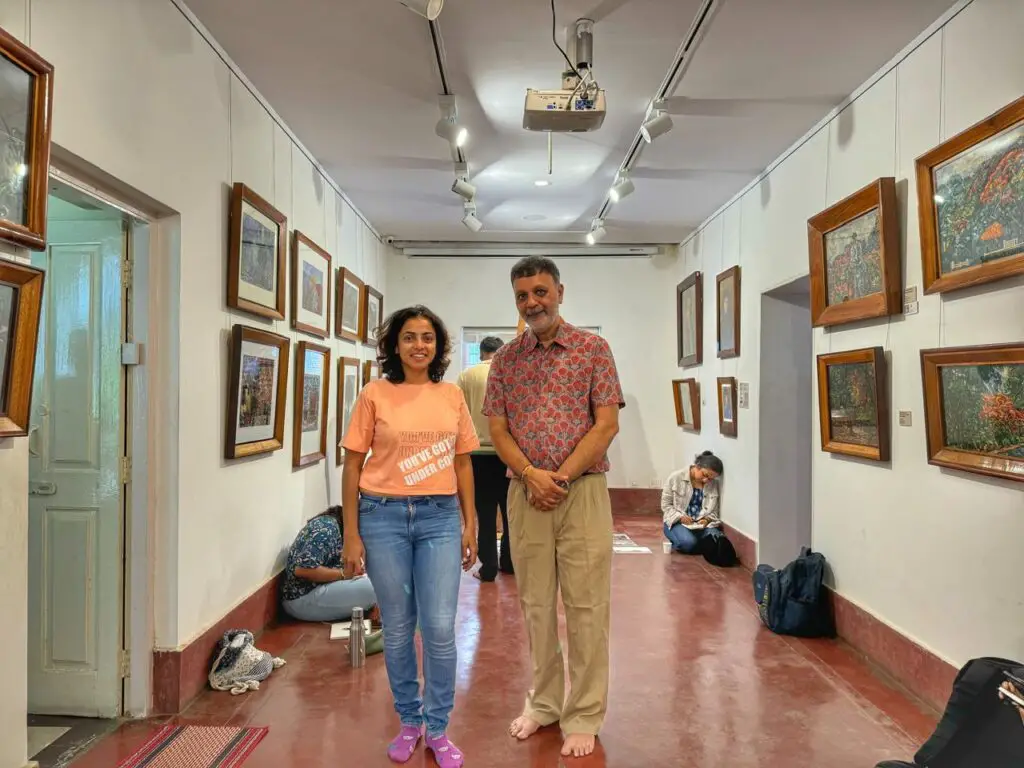
The Art House is an exhibition space and cultural hub for art enthusiasts. Visitors can explore a documentary detailing Rumale’s life and artistic journey, as well as a library with books and articles dedicated to his work. A gift shop also offers reproductions and merchandise, allowing visitors to take a piece of Rumale’s artistry home.
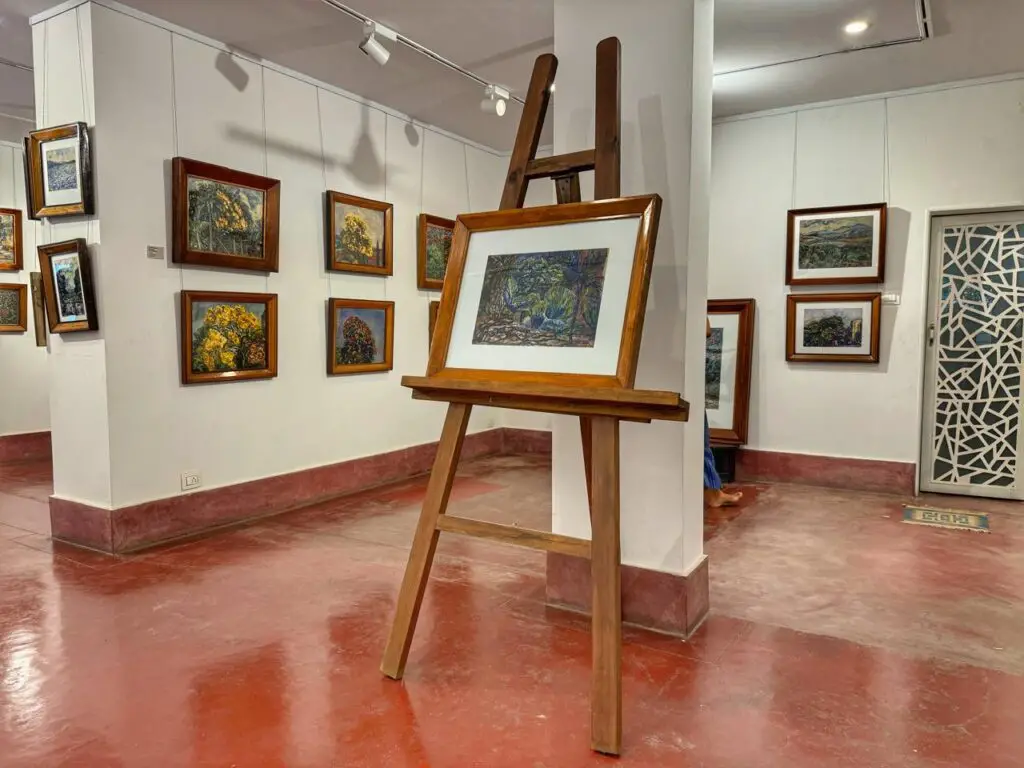
Open from 10 AM to 5 PM, Monday to Saturday, Rumale Art House offers free admission, making it accessible to all. The gallery provides a serene atmosphere in which to appreciate Rumale’s celebrated depictions of nature and Bengaluru‘s streetscapes. As a significant part of Bengaluru‘s art scene, Rumale Art House is a must-visit destination for those looking to immerse themselves in the vibrant world of this remarkable artist.
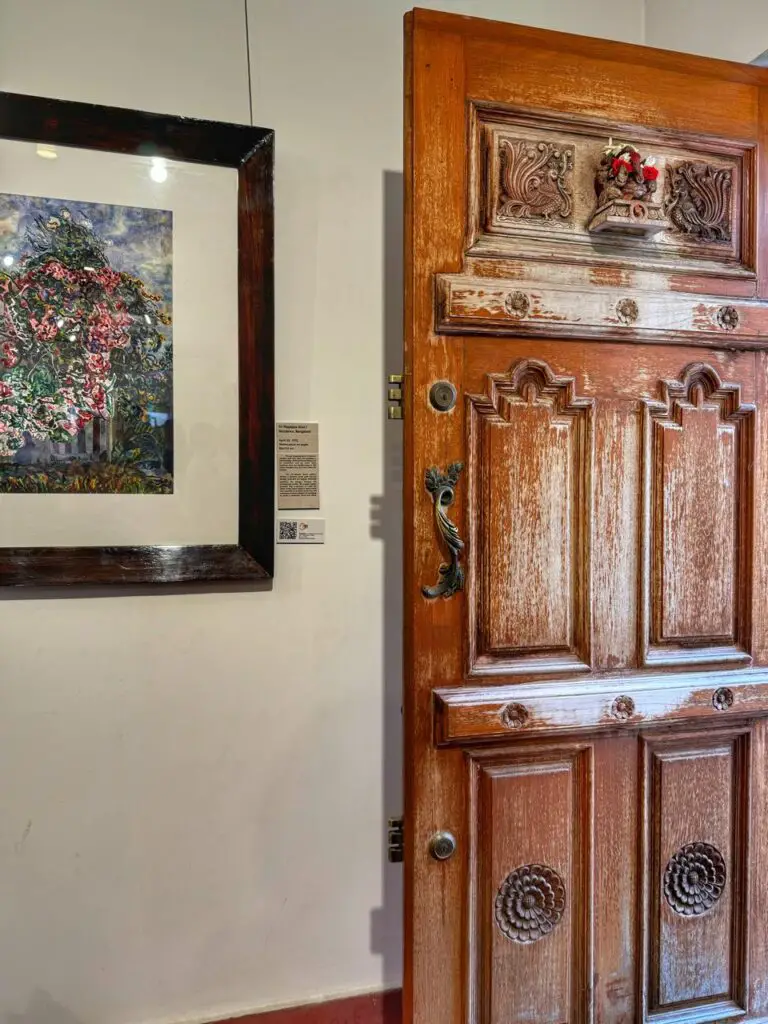
Visitor Information
- Location: 674, 45th Cross Rd, 3rd Block, Rajajinagar, Bengaluru.
-
Opening Hours:
- Monday to Saturday: 10 AM to 5:00 PM
- Closed on Sundays.
- Admission Fee: Free entry is available for all visitors.
- Exhibits: Approximately 120 original works of Rumale Chennabasaviah, with around 90 frames on display at any given time.
- A documentary showcasing Rumale’s life and artistic journey.
- Library with books and articles on Rumale and his art.
- Gift shop offering prints and merchandise related to Rumale’s artwork.
- Accessibility: Open to all art enthusiasts, families, and students.
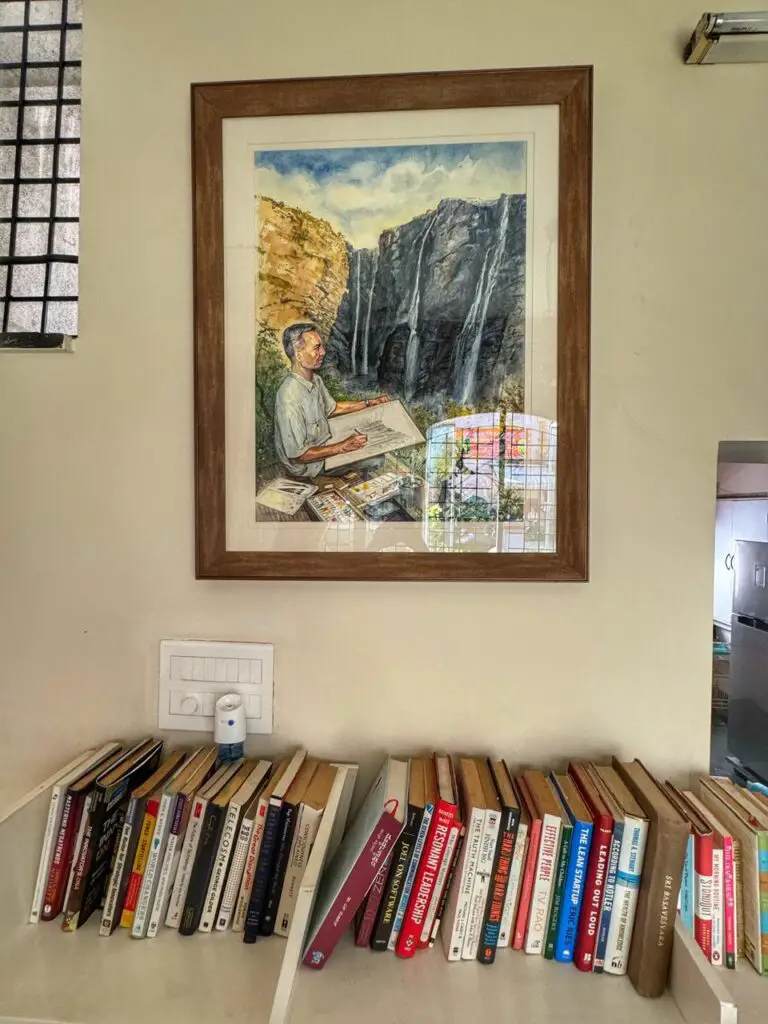
How to Get to Rumale Art House?
By Road
Rumale Art House is approximately 6 kilometres from the centre of Bengaluru. Depending on traffic conditions, it typically takes about 20 to 30 minutes to reach the gallery by road. Street parking is available on the premises.
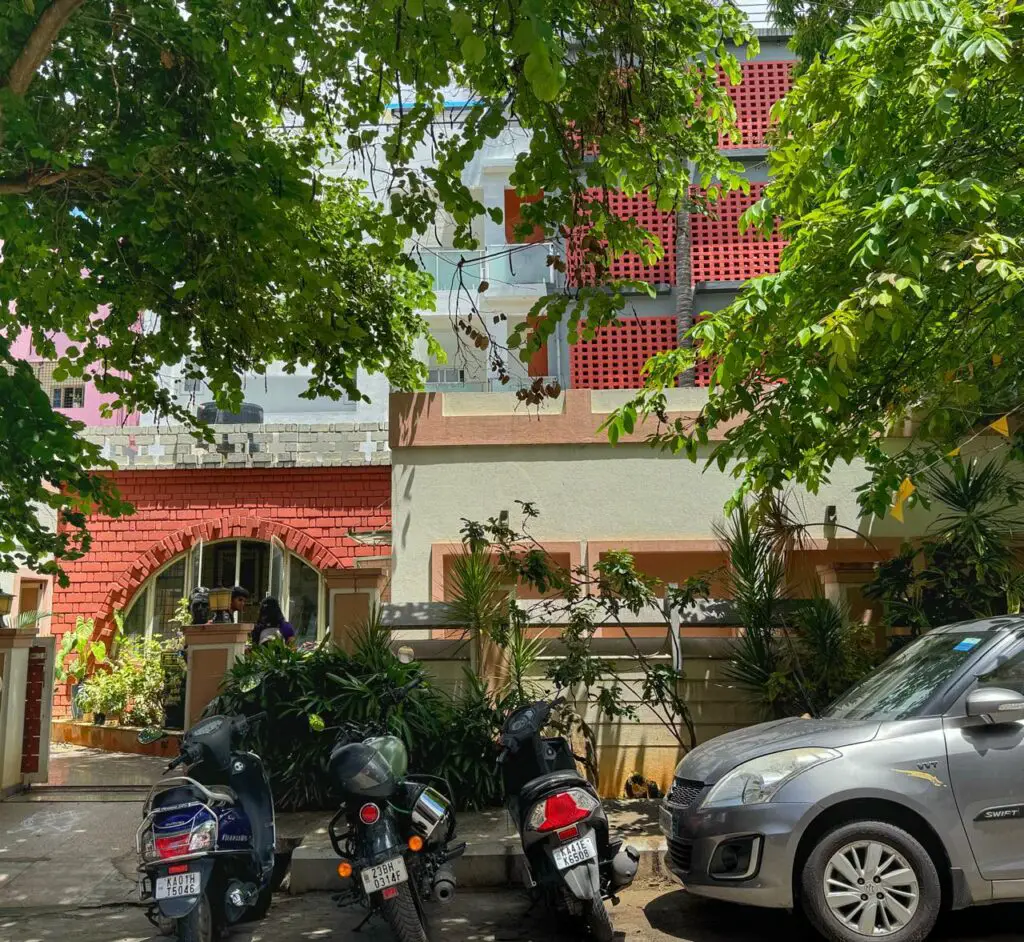
By Public Transport
Reach Rumale Art House by public transport, which is around 6 kilometres from the centre of Bengaluru. You can take a bus or the metro. The journey usually takes about 30 to 45 minutes, depending on traffic and waiting times for public transport. Several bus routes connect the city centre to Rajajinagar, making it relatively easy to reach the gallery. If you prefer the metro, you can take the Green Line to the Rajajinagar station, a short distance from the art house.
Closing Notes
Rumale Art House is more than just a gallery; it is a tribute to the artistic legacy of Rumale Chennabasaviah, often referred to as the “Van Gogh of Karnataka.” His paintings, rich in colour and emotion, capture the essence of Bengaluru‘s landscapes and the vibrancy of nature.
Visiting the art house provides an opportunity to immerse yourself in the life and work of a multifaceted artist who dedicated himself to his craft and the nation. The gallery showcases a collection of his stunning artworks and offers insights into his journey as a freedom fighter and social activist.
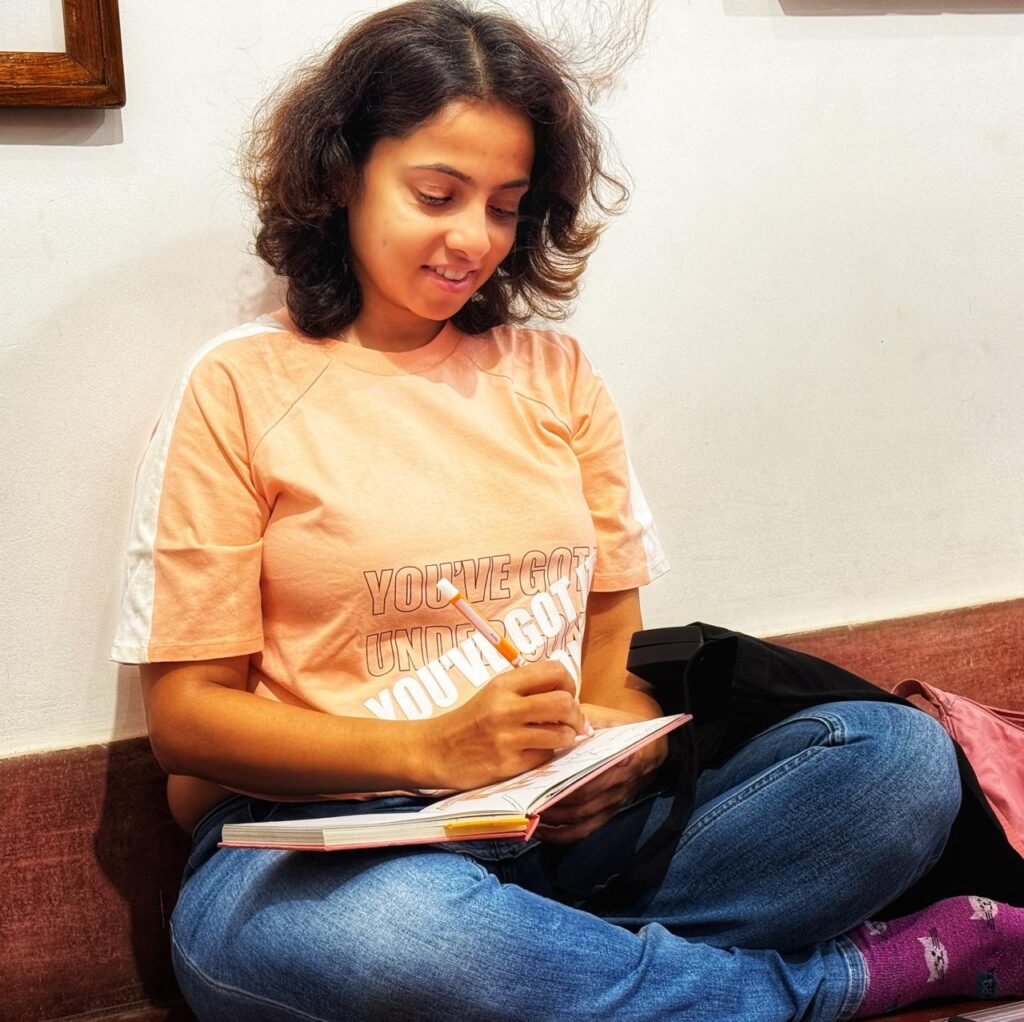
Rumale Art House promises a unique experience. As you walk through its halls, you will feel the spirit of Rumale, whose passion for art and nature continues to inspire generations.
How Can You Support Me?
You know I love coffee, so you can buy me a coffee – Buy Me Coffee!
If you enjoyed and liked this article, comment, tweet, and share this post.
Do you have a question or a suggestion? Or want to know more information? Write to me at bengaluruprayana@gmail.com.
Subscribe to My Newsletter
PIN for later reference – Rumale Art House
